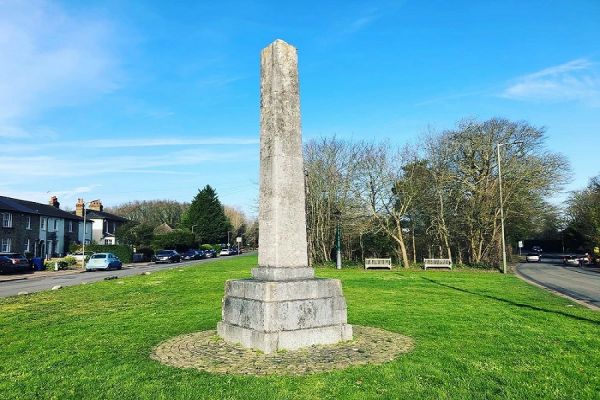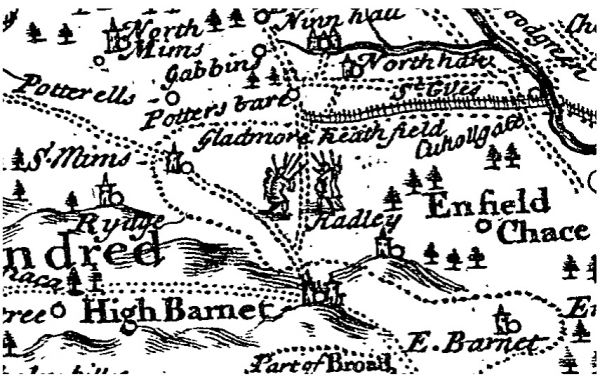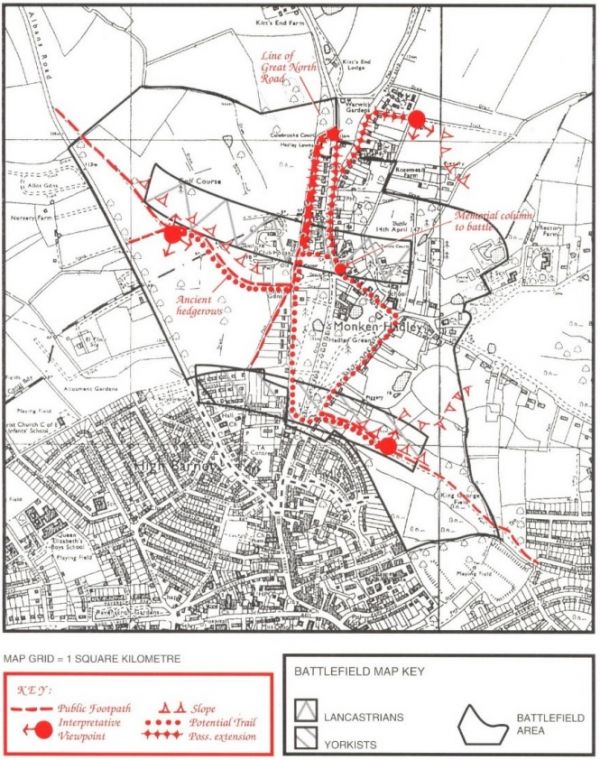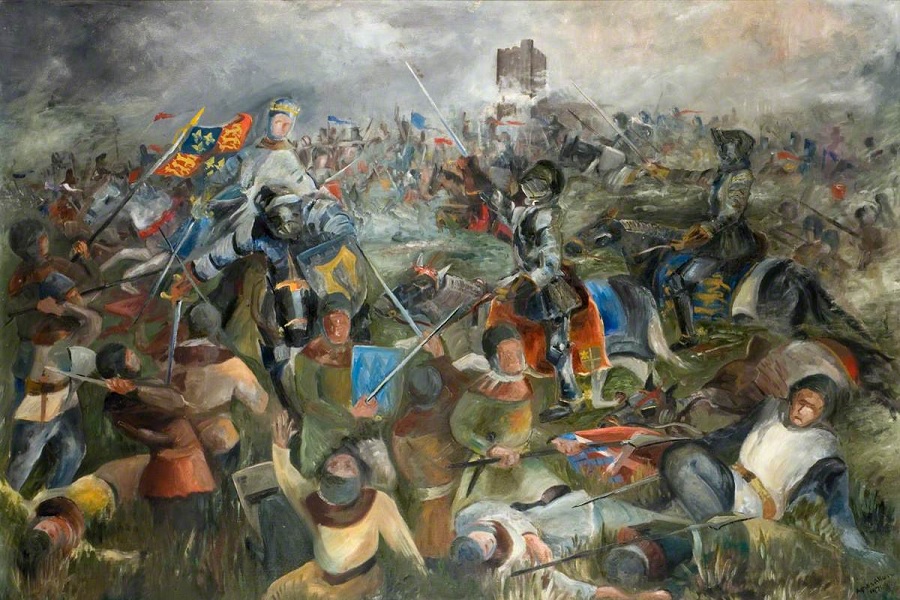The Battle of Barnet and the Great North Road
The Battle of Barnet may sound like a dispute between commuters on the Northern Line but in fact took place in 1471 and some 3,000 people died. It was one of the decisive battles of the War of the Roses and helped secure Edward IV’s position as King (for a while).
The skirmishes between the Earl of Warwick’s 15,000 Lancastrians and Edward’s 10,000 Yorkists took place either side of the Great North Road. Warwick lost his life a short distance from the road between Barnet and Potters Bar.
The Battle of Barnet is commemorated by an obelisk at the junction of the now A1000 and Kitts End Road. The sandstone obelisk was set up by Sir Jeremy Sambrooke in 1740 and provides the name of the area, Hadley Highstone. The monument reads:
“Here was fought the famous battle between Edward IV and the Earl of Warwick April 14th Anno 1471 in which the Earl was Defeated and Slain”
Barnet is about 12 miles north of London. The route to the northwest originally branched off the Great North Road at Hadley Highstone though the 18th century turnpike intersected a little to the south along what is now the A1081 St Albans road. This was Telford’s great turnpike road to Holyhead, broadly equivalent to the Roman Watling Street or the modern A5.


About the Battle of Barnet
There are many accounts of the Battle of Barnet, often with so much detail they are challenging to follow. We will go for the “Reduced Shakespeare” approach and try to sum everything up in as few words as possible.
Who started the Wars of the Roses?
The battle was the culmination of many decades of political scheming and family disputes. It all goes back to Edward III who effectively started the whole mess.
Edward III had 5 sons – Edward (whose son became Richard II), Lionel, John (1st Duke of Lancaster), Edmund (1st Duke of York), and Thomas.
Richard II became king in 1377 when he was 10. He went on to upset many people including the peasants, many nobles and many of his cousins and uncles. When Henry Bollingbroke (son of Uncle John) became next in line, Richard had him exiled to France, and left Uncle Edmund in charge whilst he popped over to Ireland. BUT Henry invaded from France, Edmund switch allegiance. Richard II abdicated in 1399 and died in Pontefract Castle dungeon the following year. Bollingbroke became King Henry IV (and inherited the “House of Lancaster” from his mum).
Despite rebellions, divisions and assassination attempts Henry IV, and his rather more capable son Henry V, clung on to power. In 1422 the crown passed to the grandson, another Henry aged 9 months. He also technically assumed the French throne – though England and France were at war and the French had other plans. His mother, Catherine, was French and was viewed with suspicion; she was not allowed to raise young King Henry, was moved to another castle (then soon remarried a young Welsh courtier, Owen Tudor).
The meek and nervous Henry VI founded colleges in Oxford and Cambridge but left large vacuums in political spheres: later, when afflicted with mental illness, he became catatonic and unresponsive to the world for a year. He married Margaret of Anjou in a deal which gifted Maine and Anjou to France – causing widespread indignation in England. Margaret wore the trousers and was not afraid of creating enemies. Richard of York (grandson of Edmund) was exiled to Ireland as “governor”. England was increasingly lawless, and in France, England was humiliated by Jean of Arc.
The rebellious nobility of England invited Richard, Duke of York, to return from Ireland and tackle incompetence and corruption. The queen and her close advisor, Edmund Beaufort (grandson of John, 1st Duke of Lancaster) resisted and civil war broke out.
Major Battles of the Wars of the Roses
There were numerous battles and atrocities over a period of 30 years. Battles were short and fierce; prisoners were rarely taken; a generation of English nobility was killed.
Year – Location – Winner
1455 – St. Albans – York
1459 – Blore Heath – York
1459 – Ludford Bridge – Lancaster
1460 – Northampton – York
1460 – Wakefield – Lancaster
1461 – Mortimers Cross – York
1461 – St. Albans – Lancaster
1461 – Towton – York
1464 – Hedgeley Moor – York
1464 – Hexham – York
1469 – Edgecote – Lancaster
1470 – Losecoat Field – York
1471 – Barnet – York
1471 – Tewkesbury – York
1485 – Bosworth – Henry VII
The near complete destruction of a Lancastrian army at Towton saw Edward IV become the first Yorkist king, deposing Henry and Margaret. Henry VI was re-crowned in 1470 and Edward left for Burgundy.
Richard III was the second and final Yorkist king.
Then, at Bosworth Field, Henry Tudor killed Richard ending the Wars of the Roses, with both sides annihilated. The Plantagenets, who had ruled for nearly 500 years, were finished.
What happened at the Battle of Barnet?
In March 1471 Edward returned to England, with the assistance of his brother-in-law the Duke of Burgundy. The decisive battles at Barnet and Tewkesbury took place within a 3-week period.
Landing in Yorkshire, Edward assembled troops and equipment and headed south via York, Doncaster and Nottingham, gathering more troops as he went. Edward reached London unopposed on 12 April, despatching Henry VI to the Tower. The Earl of Warwick had been in the Midlands raising troops marched towards London to confront his former ally.
With a Lancastrian army of 15,000 troops he took up position about a mile north of Barnet on 13 April. Edward arrived from the south with slightly fewer troops which he deployed that evening in a marshy valley north of High Barnet. On a foggy Easter Sunday morning, the Warwick’s artillery bombardment went over the heads of Edward’s troops who were positioned closer than he realised. Confusion reigned and at one-point factions of the Lancastrians fired on each other. Edward went on to secure a resounding victory. Casualties included both Richard Neville (Earl of Warwick) and his brother John Neville (Marquess of Montagu).
Where was the Battle of Barnet?
The exact location of the battlefield has not been unambiguously identified. Contemporary accounts include descriptions of the landscape. Not long after the battle, a chantry chapel was established at the site in memory of those who died. And since the 16th century maps have included a location for the battlefield. However, there are inconsistencies and the expected trove of weaponry and bodies has yet to be found.
A project undertaken in conjunction with Huddersfield University researchers has assembled all the evidence and makes an educated guess. The most likely location is an area known as Kicks End (or Kitt’s End) Common. Nearby there was formerly a moated hermitage which may have been on the same site as the earlier chapel.
In 1512 the Great Chronicle of London recorded that:
“at this ffeyld was slayn of the Comons upon both partyes iii M men or therabowth which were buried In the said playn well upon half a myle from the Town where afftyr was byldyd a lytyll Chapell to remember the sawlys of theym that wer slayn at that ffyeld…”.
Other documentation suggests the chapel was on the “hethe yn Southmyms” and continued in use until the 1530. Later it was incorporated into a moated dwelling, rebuilt in the 1650s and demolished in the 1780s.

Key Battle of Barnet Locations against Route of Great North Road (Google Earth background)

Early maps such as that of John Norden in 1598 depict the battlefield straddling the main road, but this may have been artistic licence.

The Registered Battlefield at Barnet from the report prepared by the National Army Museum that underpinned its registration by English Heritage in 1995. This positions the battle to the south, close to Hadley Highstone.
More Information about the Battle of Barnet
The Barnet Battlefield Project 2015-2018
The Battle of Barnet | Wars of the Roses – The YouTube History Chap
The image at top of page is a 1971 painting by Agnes Allen, courtesy of Barnet Museum

